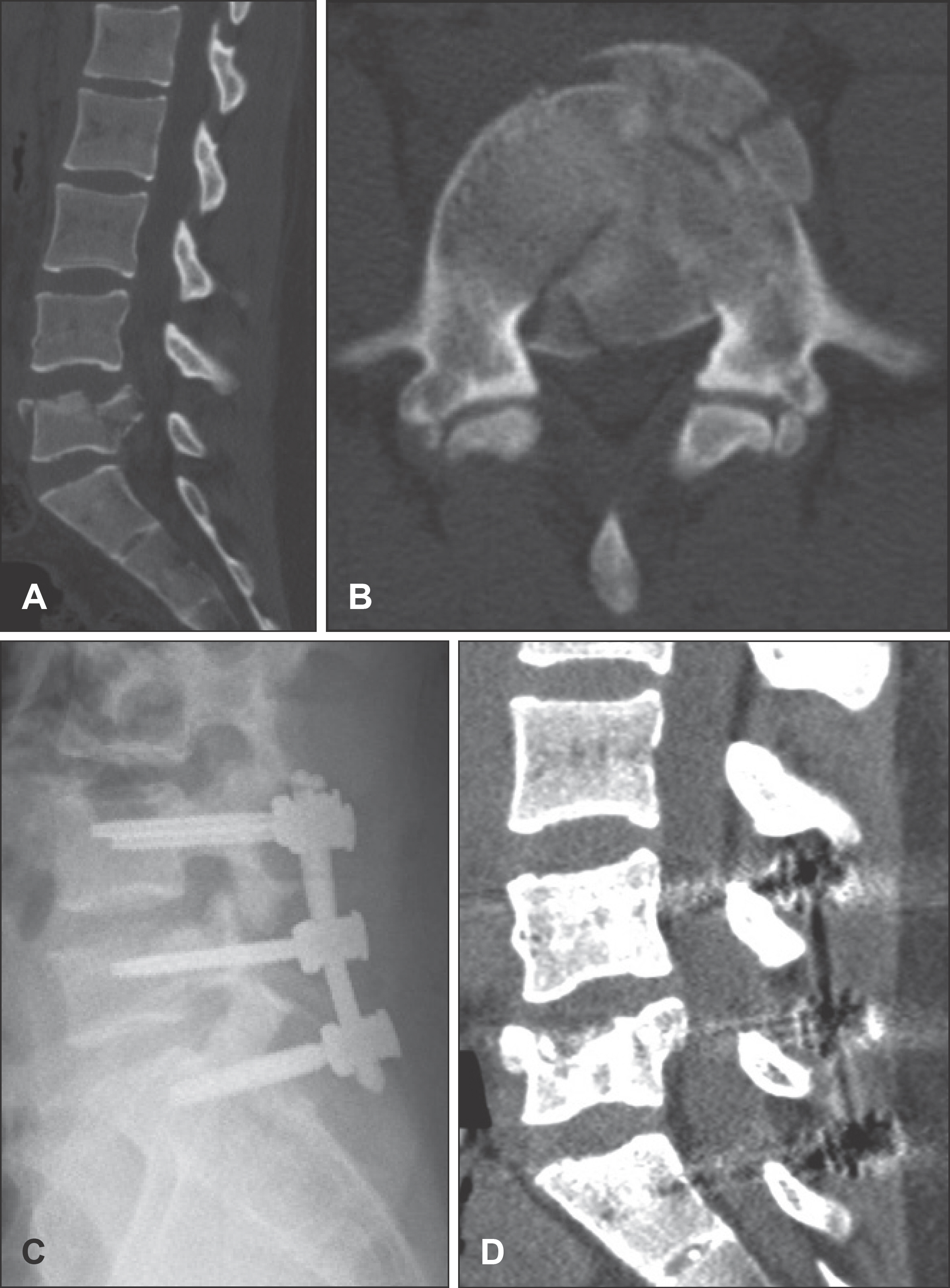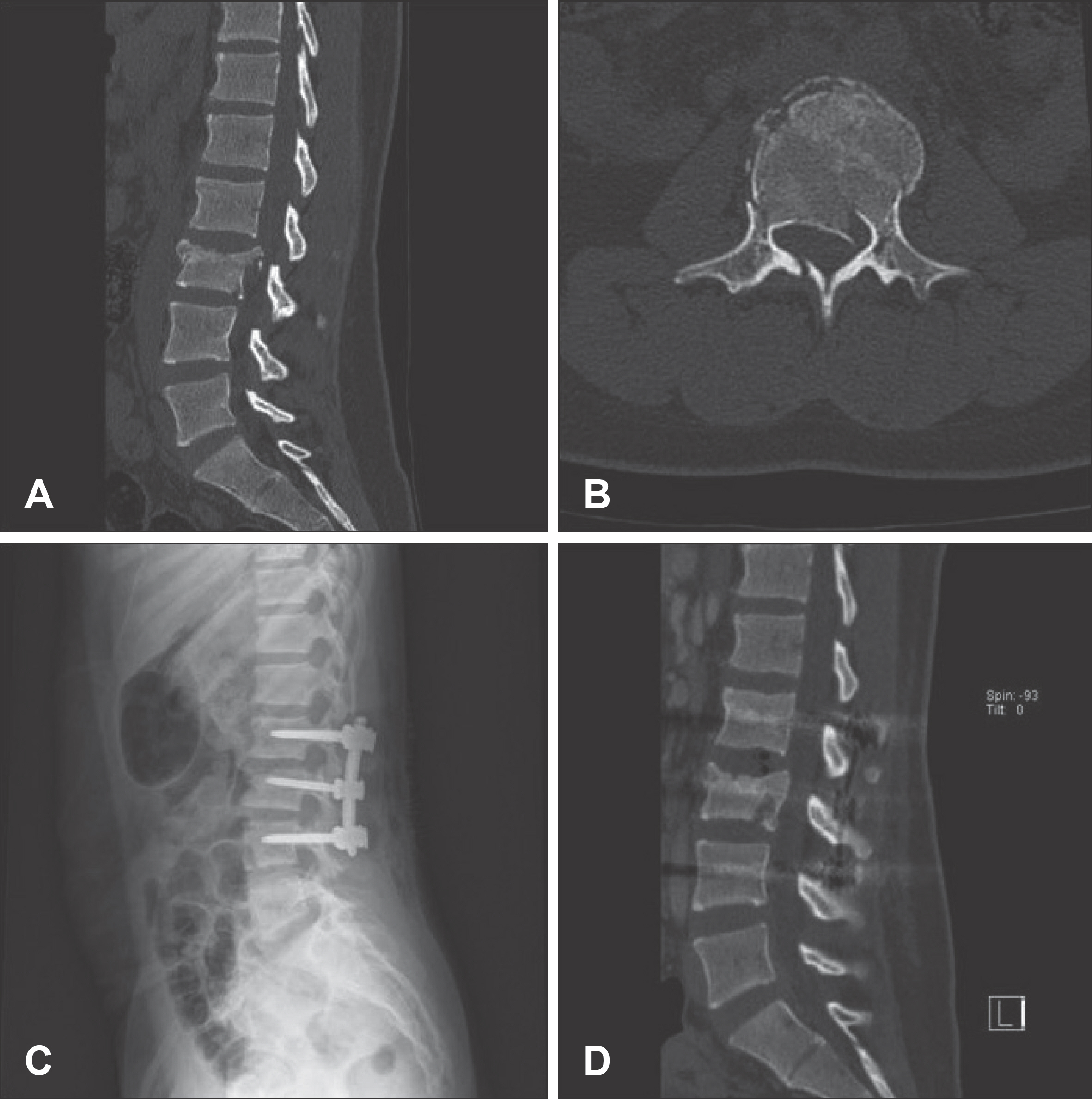Korean J Neurotrauma.
2013 Oct;9(2):101-105. 10.13004/kjnt.2013.9.2.101.
Short Segment Screw Fixation without Fusion for Low Lumbar Burst Fracture: Severe Canal Compromise but Neurologically Intact Cases
- Affiliations
-
- 1Department of Neurosurgery, College of Medicine, Chosun University, Gwangju, Korea. ns64902@hanmail.net
- KMID: 2156109
- DOI: http://doi.org/10.13004/kjnt.2013.9.2.101
Abstract
OBJECTIVE
The purpose of this study was to determine whether screw fixation without bone fusion in patients with a low lumbar burst fracture has satisfactory outcomes.
METHODS
Twelve patients that underwent screw fixation without bone fusion for a low lumbar burst fracture (L3-5) between 2006 and 2009, were included in this study. Motor power was intact despite severe canal compromise in all. Surgical procedures included postural reduction for 2 days and screw fixation without bone fusion. Imaging and clinical findings, including level of the involved vertebra, vertebral height, canal compromise, clinical outcomes, and related complications were analyzed.
RESULTS
Mean follow-up was 23.1+/-11.0 months. Mean pain score (visual analogue scale) prior to surgery was 7.8+/-2.0 and this decreased to 1.8+/-1.0 at final follow-up. In 5 patients, open screw fixation by midline skin incision was performed and 7 patients underwent percutaneous screw fixation at one level above, one level below the fractured vertebra and fractured level itself. The proportion of canal compromise at the fractured level improved significantly from 60% to 30% at final follow-up (p<0.001). Mean preoperative vertebral height loss was 31.0%, and improved to 20.5% at final follow-up, though this improvement was not statistically significant (p<0.001). No neurological aggravation related to neural injury was observed.
CONCLUSION
Short segment pedicle screw fixation without bone fusion can be an effective and safe operative technique for the management of selected low lumbar burst fractures.
Keyword
Figure
Cited by 1 articles
-
Missed Cauda Equina Syndrome after Burst Fracture of the Lumbar Spine
Jin Hyuk Bang, Keun-Tae Cho
Korean J Neurotrauma. 2015;11(2):175-179. doi: 10.13004/kjnt.2015.11.2.175.
Reference
-
References
1. An HS, Simpson JM, Ebraheim NA, Jackson WT, Moore J, O'Malley NP. Low lumbar burst fractures: comparison between conservative and surgical treatments. Orthopedics. 15:367–373. 1992.
Article2. An HS, Vaccaro A, Cotler JM, Lin S. Low lumbar burst fractures. Comparison among body cast, Harrington rod, Luque rod, and Steffee plate. Spine (Phila Pa 1976) 16 (8 Suppl):S440-S444. 1991.3. Chan DP, Seng NK, Kaan KT. Nonoperative treatment in burst fractures of the lumbar spine (L2-L5) without neurologic deficits. Spine (Phila Pa 1976). 18:320–325. 1993.
Article4. Gahr RH, Strasser S, Strasser E, Schmidt OI. Percutaneous internal fixation of thoracolumbar spine fractures. Top Spinal Cord Inj Rehabil. 12:45–54. 2006.
Article5. Huang QS, Chi YL, Wang XY, Mao FM, Lin Y, Ni WF, et al. [Comparative percutaneous with open pedicle screw fixation in the treatment of thoracolumbar burst fractures without neurological deficit]. Zhonghua Wai Ke Za Zhi. 46:112–114. 2008.6. Jang KS, Ju CI, Kim SW, Lee SM. Screw Fixation without Fusion for Low Lumbar Burst Fracture: A Severe Canal Compromise But Neurologically Intact Case. J Korean Neurosurg Soc. 49:128–130. 2011.7. Jung JR, Park SB. Clinical and radiological analysis of thoracoscopic spinal surgery in thoracolumbar burst fracture. J Korean Neurotraumatol Soc. 7:24–28. 2011.
Article8. Kostuik JP. Anterior fixation for burst fractures of the thoracic and lumbar spine with or without neurological involvement. Spine (Phila Pa 1976). 13:286–293. 1988.
Article9. Mohanty SP, Venkatram N. Does neurological recovery in thoracolumbar and lumbar burst fractures depend on the extent of canal compromise? Spinal Cord. 40:295–299. 2002.
Article10. Okuyama K, Abe E, Chiba M, Ishikawa N, Sato K. Outcome of anterior decompression and stabilization for thoracolumbar unstable burst fractures in the absence of neurologic deficits. Spine (Phila Pa 1976). 21:620–625. 1996.
Article11. Seybold EA, Sweeney CA, Fredrickson BE, Warhold LG, Bernini PM. Functional outcome of low lumbar burst fractures. A multicenter review of operative and nonoperative treatment of L3-L5. Spine (Phila Pa 1976). 24:2154–2161. 1999.12. Wang ST, Ma HL, Liu CL, Yu WK, Chang MC, Chen TH. Is fusion necessary for surgically treated burst fractures of the thoracolumbar and lumbar spine?: a prospective, randomized study. Spine (Phila Pa 1976). 31:2646–2652. ;discussion 2653,. 2006.
- Full Text Links
- Actions
-
Cited
- CITED
-
- Close
- Share
- Similar articles
-
- Screw Fixation without Fusion for Low Lumbar Burst Fracture : A Severe Canal Compromise But Neurologically Intact Case
- Short Segment Screw Fixation without Fusion for Unstable Thoracolumbar and Lumbar Burst Fracture : A Prospective Study on Selective Consecutive Patients
- Change of Canal Compromise After Ligamentotaxis in Thoracolumbar Burst Fracture
- Short- and Long-segment Pedicle Screw Fixation with Anterior Interbody Fusion with Short Bone Graft in Denis type B Burst Fractures
- Bone Cement-Augmented Short Segment Fixation with Percutaneous Screws for Thoracolumbar Burst Fractures Accompanied by Severe Osteoporosis



